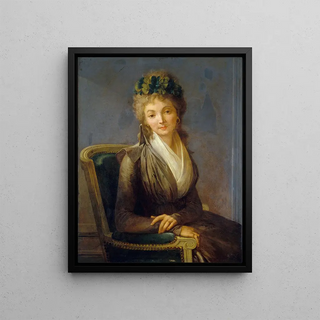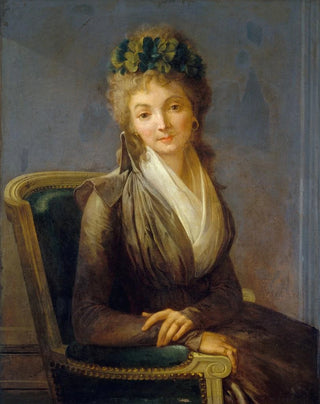Art print | Presumed portrait of Lucile Desmoulins - Louis Léopold Boilly


View from behind

Frame (optional)
Portrait of Lucile Desmoulins - Louis Léopold Boilly – Captivating Introduction
The "Portrait of Lucile Desmoulins" by Louis Léopold Boilly is a work that transcends the simple frame of a painting to become a true testament to its era. Created at the end of the 18th century, this piece evokes not only the beauty and elegance of its model but also the political and social upheavals shaking France at that time. Lucile Desmoulins, an iconic figure of the French Revolution, embodies a strong femininity, both gentle and resilient. Through this portrait, Boilly does not merely capture the appearance of his subject but manages to convey a psychological depth that invites viewers to reflect on the identity and role of women in a society in full transformation.
Style and uniqueness of the work
Boilly's style is distinguished by his meticulous attention to detail and his ability to render human expression with rare intensity. In this portrait, light plays a crucial role, highlighting Lucile's delicate features while creating an intimate atmosphere. The colors, subtly chosen, evoke a soft palette that enhances the tenderness of the protagonist's gaze. Boilly also employs trompe-l'œil techniques, rendering textures and fabrics so realistically that one could almost touch the silk of her dress. The composition is carefully orchestrated, with a background that, although discreet, contributes to the story told by the painting. Every element, from the sparkling jewelry to the sparkle in Lucile's eyes, is designed to capture attention and evoke emotion, making this work a centerpiece of French portraiture.
The artist and his influence
Louis Léopold Boilly, born in 1761, was an artist who skillfully navigated between the styles and artistic currents of his time. Raised in a context where neoclassicism and romanticism were beginning to take shape, he established himself as a master of portraiture, capable of capturing not only appearance but also the soul of his subjects. His work is marked by a particular sensitivity to the

Matte finish

View from behind

Frame (optional)
Portrait of Lucile Desmoulins - Louis Léopold Boilly – Captivating Introduction
The "Portrait of Lucile Desmoulins" by Louis Léopold Boilly is a work that transcends the simple frame of a painting to become a true testament to its era. Created at the end of the 18th century, this piece evokes not only the beauty and elegance of its model but also the political and social upheavals shaking France at that time. Lucile Desmoulins, an iconic figure of the French Revolution, embodies a strong femininity, both gentle and resilient. Through this portrait, Boilly does not merely capture the appearance of his subject but manages to convey a psychological depth that invites viewers to reflect on the identity and role of women in a society in full transformation.
Style and uniqueness of the work
Boilly's style is distinguished by his meticulous attention to detail and his ability to render human expression with rare intensity. In this portrait, light plays a crucial role, highlighting Lucile's delicate features while creating an intimate atmosphere. The colors, subtly chosen, evoke a soft palette that enhances the tenderness of the protagonist's gaze. Boilly also employs trompe-l'œil techniques, rendering textures and fabrics so realistically that one could almost touch the silk of her dress. The composition is carefully orchestrated, with a background that, although discreet, contributes to the story told by the painting. Every element, from the sparkling jewelry to the sparkle in Lucile's eyes, is designed to capture attention and evoke emotion, making this work a centerpiece of French portraiture.
The artist and his influence
Louis Léopold Boilly, born in 1761, was an artist who skillfully navigated between the styles and artistic currents of his time. Raised in a context where neoclassicism and romanticism were beginning to take shape, he established himself as a master of portraiture, capable of capturing not only appearance but also the soul of his subjects. His work is marked by a particular sensitivity to the






